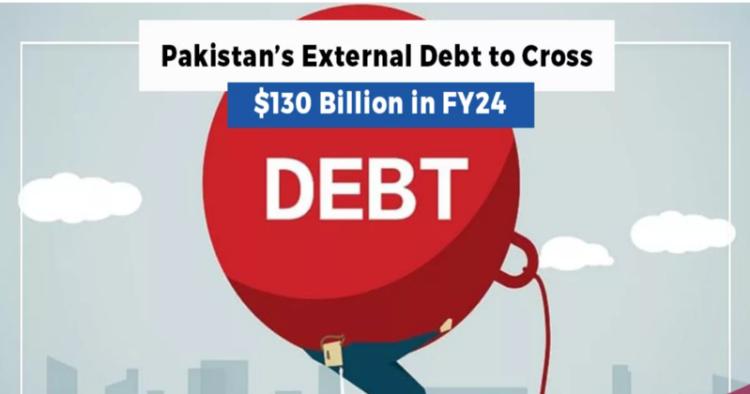Pakistan’s total debts and liabilities increased to a record of Rs 81 trillion during the past year. It is presently scouting for new sources of financing/borrowings to meet its debt servicing needs. In dollar terms, its external debts had crossed $130.4 billion by the end of March 2024, an increase of $3 billion in the last year, according to the State Bank of Pakistan (SBP).
This debt burden is equal to 75 per cent (three-fourths) of Pakistan’s total economy. This is far in excess than the statutory limit prescribed by its own Fiscal Responsibility and Debt Limitation Act. The Act of 2005 was amended in May 2022 to strengthen the Debt Office for effective planning and execution of debt management functions. It had taken one year to get the Act passed at that time, as it had been moved a year earlier, in April 2021.
In May 2022, the debt burden was pegged at 72 per cent and the Act had said that the short term aim was to bring it down to 70 per cent. It had also said that the government will seek to bring down debt to GDP ratio to 60 per cent in six years at the rate of two per cent reduction per annum. However, the latest SBP figures tell a different story that instead of a reduction to 60 per cent, the debt to GDP ratio has galloped to 75 per cent.
Incidentally, due to Pakistan’s low credit ratings, most foreign commercial banks now do not extend new loans to Pakistan. As such, IMF, considered the creditor of the last resort globally, has become the first choice for Pakistan for borrowings. Incidentally, Pakistan owes over $7.5 billion to the IMF and is still looking for more loans from it. An IMF team is presently in Pakistan, holding discussions with officials regarding the quantum and duration of a new loan that it wants from the lender.
Successive governments have talked of austerity measures, economic reforms, and curbing fiscal deficits—measures that can reduce debt burden. However, these have remained rhetorical statements only, as no government has taken concrete measures to curb rising debts. None of the three mainstream political parties, PML-N, PPP or PTI, is willing to undertake serious reforms to do debt restructuring. All these parties know that any reforms are likely to bring more hardships for the masses and are, as such, unpopular.
Incidentally, over a decade ago in 2012, Transparency International (TI) had calculated that Pakistan had lost more than Rs 8.5 trillion ($94 billion) in corruption, tax evasion, and bad governance. According to TI Pakistan: “If Pakistan checked the menace of corruption, it would not require a single penny from the outside world.” But rampant corruption at all levels in public life did not come down after that report but actually took new areas into its embrace ever since.
At a conservative estimate, the revenues collected by the government only cover around 60 per cent of total expenditures. The remaining 40 per cent of the expenditures are financed through borrowings, mostly through domestic banks. The government is essentially borrowing to repay debts adding to the future cost of borrowing and worsening the fiscal deficit situation.
During the current fiscal year, Pakistan has achieved a dubious distinction as the cost of interest payments made for servicing its past debts has exceeded the net federal income.
In January 2023, Pakistan owed $100 billion to the world, according to former Finance Minister Miftah Islah. At present, the country is trying to take money from fresh creditors to pay old debts. In the past two decades also, Pakistan’s economy was propped up artificially by massive grants from the western countries led by the US. Late in 2001, Pakistan joined the US-led coalition in its “war on terror’’ and that led to the West writing off most of its debts.
It bears mention here that the financial year of Pakistan starts on July 1 and ends on June 30. As such, the financial year 2023–24 is reaching its fag end and soon a new financial year will start. During FY 2024-25, the country is required to service the external debts of at least $25 billion. For the next three financial years (or 36 months), the total debt liabilities of Pakistan stand at approximately $72 billion, which translates to $2 billion per month.
In the past couple of years, Pakistan has managed to avoid sovereign default due to the repeated rollover of debts by China, Saudi Arabia and United Arab Emirates (UAE). Despite these responses, things have changed very little regarding mismanagement of its economy. There was some hope for reviving the economy, as Finance Minister Muhammad Aurangzeb wanted to raise some money by selling State Owned Enterprises (SOEs). However, he has been halted in his tracks, and the government has not finalised the list of SOEs it wants to sell.














Comments